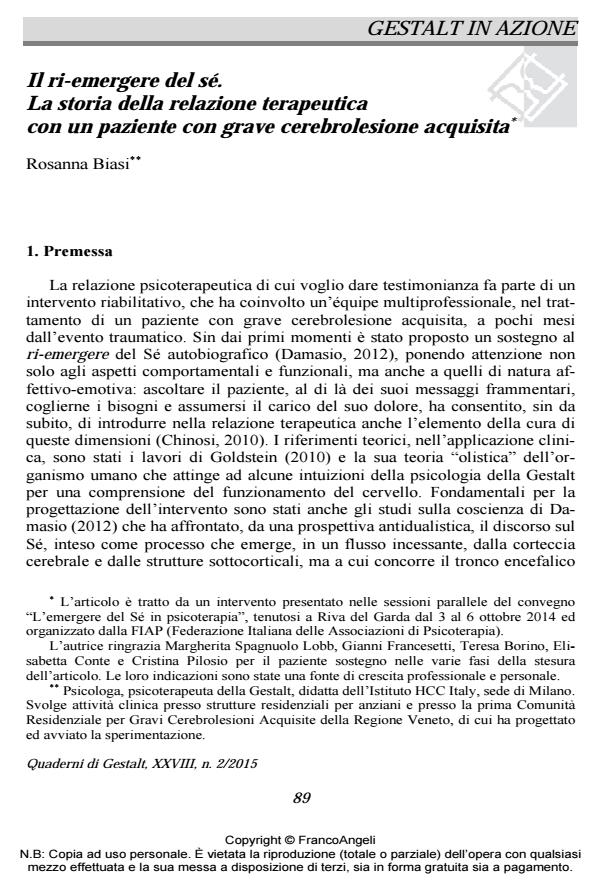The Re-emerging of the Self. The History of the Therapeutic Relationship with a Patient with Severe Acquired Brain Injury
Journal title QUADERNI DI GESTALT
Author/s Rosanna Biasi
Publishing Year 2016 Issue 2015/2 Language Italian
Pages 13 P. 89-101 File size 205 KB
DOI 10.3280/GEST2015-002006
DOI is like a bar code for intellectual property: to have more infomation
click here
Below, you can see the article first page
If you want to buy this article in PDF format, you can do it, following the instructions to buy download credits

FrancoAngeli is member of Publishers International Linking Association, Inc (PILA), a not-for-profit association which run the CrossRef service enabling links to and from online scholarly content.
This work, which supports a relational environmental emergence of the self, presents a multidisciplinary rehabilitation intervention in the case of a patient who has suffered a brain injury in a car accident. Psychotherapeutic intervention, containment and rhythm of environmental stimulation has supported a new adjustement. The patient’s sense of the self has progressively increased. Form the trauma onward, moments of possible contact with the environment became more and more evident.
Keywords: Brain injury, brain injury rehabilitation, acquired disability, psychotherapy with brain injury, community for people who suffer brain injuries.
- Cavaleri P.A., a cura di (2013). Psicoterapia della Gestalt e neuroscienze. Dall’isomorfismo alla simulazione incarnata. Milano: FrancoAngeli.
- Chinosi E. (2010). Il contenitore nella relazione con il paziente affetto da grave cerebrolesione acquisita. In: Saviola D., De Tanti A., a cura di, Trauma cranico e disabilità. Esperienze di psicoterapia. Milano: FrancoAngeli, pp. 77-104.
- Coetzer R. (2006). Traumatic Brain Injury Rehabilitation: A Psychotherapeutic Approach to Loss and Grief. New York: Nova Science Publishers.
- Damasio A. (2012). Il sé viene alla mente. Milano: Adelphi.
- Francesetti G., Ammirata M., Riccamboni S., Sgadari N., Spagnuolo Lobb M., a cura di (2014). Il dolore e la bellezza. Atti del III Convegno della Società Italiana Psicoterapia Gestalt. Milano: FrancoAngeli.
- Goldstein K. (2010). L’organismo. Un approccio olistico alla biologia derivato dai dati patologici nell’uomo. Roma: Giovanni Fioriti.
- Langer K.G., Padrone F.J. (1992). Psychotherapeutic Treatment of Awareness in Acute Rehabilitation of Traumatic Brain Injury. Neuropsychological Rehabilitation, 2, 1: 59-70. DOI: 10.1080/0960201920840139
- Mazzucchi A., a cura di (2011). La riabilitazione delle gravi cerebrolesioni acquisite. Percorsi sanitario-assistenziali, complessità gestionale, evidenza dei risultati. Firenze: Giunti O.S. Organizzazioni Speciali.
- Noë A. (2010). Perché non siamo il nostro cervello. Una teoria radicale della coscienza. Milano: Raffaello Cortina.
- Ownsworth T. (2005). The Impact of Defensive Denial upon Adjustment Following Traumatic Brain Injury. Neuro-Psychoanalysis, 7, 1: 83-94. DOI: 10.1080/15294145.2005.1077347
- Perls F., Hefferline R.F. e Goodman P. (1997). Teoria e pratica della terapia della Gestalt. Vitalità e accrescimento nella personalità umana. Roma: Astrolabio (ed. or.: Gestalt Therapy: Excitement and Growth in the Human Personality. New York: The Gestalt Journal Press, 1951).
- Spagnuolo Lobb M. (2011). Il now-for-next in psicoterapia. La psicoterapia della Gestalt raccontata nella società post-moderna. Milano: FrancoAngeli.
- Spagnuolo Lobb M. (2014). Lo sviluppo polifonico dei domini: ricadute sulla considerazione della psicopatologia e della psicoterapia. Intervento durante il meeting annuale dei didatti dell’Istituto di Gestalt H.C.C. Italy, Terrasini, 24-27 luglio (slides).
- Wilson B.A., Gracey F., Evans J.J., Bateman A. (2009). Neuropsychological Rehabilitation: Theory, Models, Therapy, and Outcome. New York: Cambridge University Press.
Rosanna Biasi, Il ri-emergere del sé. La storia della relazione terapeutica con un paziente con grave cerebrolesione acquisita in "QUADERNI DI GESTALT" 2/2015, pp 89-101, DOI: 10.3280/GEST2015-002006